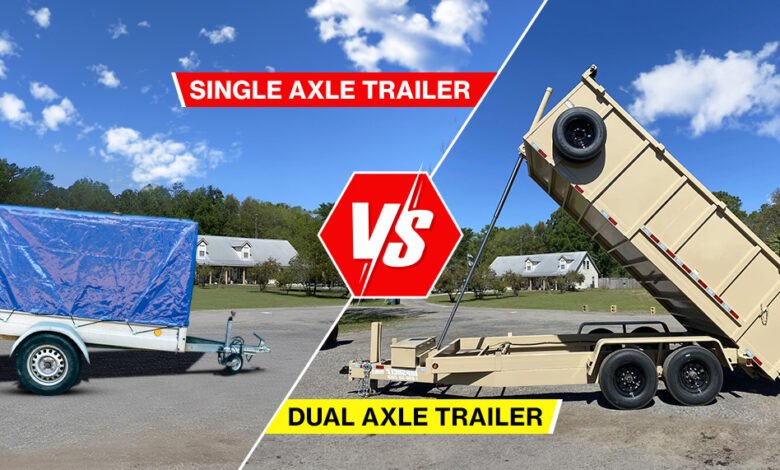Single vs Tandem Axle Trailer: Choosing the Right Trailer for Your Needs

Introduction
Choosing the right trailer can make a significant difference in hauling efficiency, safety, and long-term costs. Trailers come in various types, but one of the most common decisions people face is whether to invest in a single or tandem axle trailer. While both serve the primary function of transporting goods, their design, performance, and cost characteristics vary considerably. Understanding these differences is crucial for making an informed decision that meets your hauling needs and aligns with your budget. This article will explore the distinctions between single and tandem axle trailers, covering their advantages, disadvantages, and key considerations to help you make the best choice.
What is a Single Axle Trailer?
A single axle trailer features one set of wheels located in the center of the trailer frame. This design is simpler and lighter, making it ideal for smaller loads and easier maneuverability. Single axle trailers are often used for personal hauling tasks, such as moving small equipment, motorcycles, or light landscaping materials. Their lightweight structure allows them to be more fuel-efficient when towing and easier to store in limited spaces. Maintenance is usually less complicated because there are fewer tires, brakes, and suspension components to monitor. However, single axle trailers can be less stable, especially with heavier loads, and may experience more sway at higher speeds. Choosing a single axle trailer is often about balancing cost, simplicity, and load size.
What is a Tandem Axle Trailer?
Tandem axle trailers come equipped with two sets of wheels, offering increased stability and load-bearing capacity compared to single axle trailers. This design is commonly used for hauling heavier items, such as vehicles, construction equipment, or larger quantities of materials. The additional axle helps distribute weight more evenly, reducing wear on tires and the trailer frame while improving road stability. Tandem axle trailers also handle rough terrain more effectively, making them a reliable choice for professional or frequent hauling. On the downside, tandem axle trailers are generally more expensive upfront, require more maintenance, and can be slightly harder to maneuver in tight spaces due to the longer wheelbase. Nevertheless, their durability and performance make them a preferred choice for heavier or more frequent hauling.
Performance Comparison
When comparing single vs tandem axle trailers, performance differences are particularly evident in stability and handling. Single axle trailers are lighter and easier to maneuver, making them convenient for short trips and simple hauling tasks. However, their lighter design means they are more susceptible to swaying, especially at higher speeds or on uneven roads. Tandem axle trailers, on the other hand, offer superior stability due to their extra wheels and wider weight distribution. This makes them safer for transporting heavy loads and for driving on longer trips. While tandem axle trailers may require more skill to maneuver in tight spaces, they provide a smoother ride and greater control under challenging conditions. For those prioritizing safety and heavy hauling performance, tandem axles are often the better choice.
Maintenance and Longevity
Maintenance requirements differ significantly between single and tandem axle trailers. Single axle trailers have fewer tires, brakes, and suspension components, making routine upkeep simpler and more affordable. Inspection and replacement of parts are quicker and less costly, which is advantageous for casual users or infrequent haulers. Tandem axle trailers require more extensive maintenance due to their additional tires, brakes, and suspension systems. While this increases upkeep costs, the load distribution and reduced stress on each component generally extend the trailer’s lifespan. In the long term, tandem axle trailers can be more cost-effective for heavy or frequent hauling because they withstand wear and tear better than single axle designs. Considering both short-term and long-term maintenance is essential when deciding which trailer type suits your needs.
Cost Considerations
Cost is a major factor when choosing between single vs tandem axle trailers. Single axle trailers are generally less expensive, both in initial purchase price and ongoing maintenance. Their lighter build and simpler design make them accessible for individuals or small businesses with limited hauling needs. Tandem axle trailers, while more expensive upfront, offer greater durability, higher load capacity, and better performance for frequent or heavy-duty use. For professionals in construction, landscaping, or transportation, the investment in a tandem axle trailer can pay off in efficiency and longevity. Ultimately, your decision should weigh your budget against the type of hauling you anticipate doing, considering both short-term affordability and long-term value.
Choosing the Right Trailer for Your Needs
Selecting between a single or tandem axle trailer depends on several factors, including load size, frequency of use, and driving conditions. If your hauling tasks are light, occasional, and involve short distances, a single axle trailer may suffice. Its simplicity, lower cost, and ease of storage are major advantages. If you plan to transport heavier loads, drive long distances, or navigate challenging terrains, a tandem axle trailer offers the stability, durability, and safety you need. Additionally, consider towing capacity, trailer length, and local regulations, as these can influence which trailer type is suitable. Evaluating your specific needs ensures you invest in a trailer that is safe, efficient, and long-lasting.
Conclusion
Understanding the differences between single and tandem axle trailers is essential for making an informed investment. Single axle trailers excel in simplicity, affordability, and maneuverability, making them ideal for light hauling. Tandem axle trailers provide greater stability, higher load capacity, and enhanced durability, making them suitable for heavier and more frequent hauling. By assessing your load requirements, frequency of use, and long-term goals, you can choose the trailer that best aligns with your needs. Making the right choice not only improves hauling efficiency but also ensures safety, performance, and reliability for years to come.
FAQs
1. Can a single axle trailer carry heavy loads?
Single axle trailers are designed for lighter loads. While they can handle moderate weights, excessive weight may reduce stability and increase sway risk. For heavy hauling, tandem axle trailers are safer.
2. Are tandem axle trailers harder to tow?
Tandem axle trailers can be slightly more challenging to maneuver due to their longer wheelbase, but the increased stability and load distribution make towing safer for heavier loads.
3. Which trailer type is more cost-effective?
Single axle trailers have a lower initial cost and simpler maintenance, while tandem axle trailers offer long-term durability for frequent or heavy hauling, potentially saving money on repairs and replacements.
4. How does axle type affect trailer maintenance?
Single axle trailers have fewer components, making maintenance easier and cheaper. Tandem axle trailers require more upkeep due to extra tires, brakes, and suspension systems but generally last longer.
5. Can I convert a single axle trailer to a tandem axle?
While technically possible, converting a single axle trailer to tandem is complex and expensive. Purchasing a new tandem axle trailer is usually more practical and safer.



